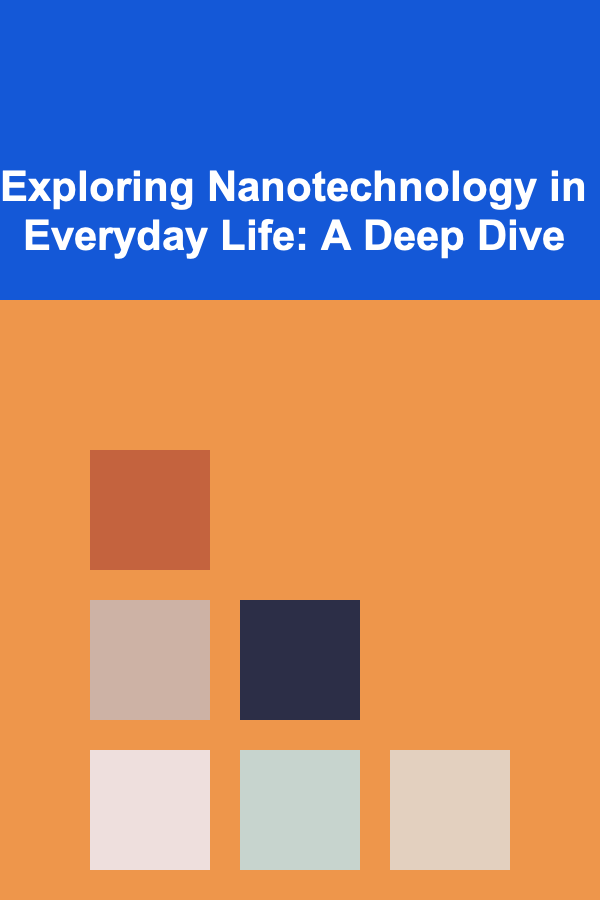
Exploring Nanotechnology in Everyday Life: A Deep Dive
ebook include PDF & Audio bundle (Micro Guide)
$12.99$6.99
Limited Time Offer! Order within the next:

Nanotechnology, the manipulation of matter on an atomic and molecular scale, is no longer a futuristic fantasy. It's a present-day reality deeply interwoven into our daily lives, often subtly enhancing products and processes we take for granted. While the term itself might conjure images of microscopic robots or self-assembling machines (and these are indeed areas of ongoing research), the pervasive impact of nanotechnology stems from more readily accessible applications that are already transforming various industries. This exploration delves into the fascinating world of nanotechnology, uncovering its presence in everyday items and examining its potential and challenges.
Understanding the Basics: What is Nanotechnology?
At its core, nanotechnology deals with structures and materials possessing dimensions between 1 and 100 nanometers (nm). A nanometer is one billionth of a meter -- to put that in perspective, a human hair is about 80,000 nanometers wide. At this scale, materials exhibit unique physical, chemical, and biological properties that are significantly different from their bulk counterparts. These altered properties, driven by quantum mechanical effects and increased surface area to volume ratios, are what make nanotechnology so revolutionary.
Imagine a cube of gold. As you divide that cube into smaller and smaller cubes, you eventually reach the nanoscale. At this point, the gold particles no longer behave as solid gold. They might melt at a lower temperature, exhibit different colors (due to quantum confinement effects), or become much more reactive. This change in behavior is the key to nanotechnology's versatility.
The term "nanotechnology" encompasses a broad range of disciplines, including:
- Nanomaterials: The creation and manipulation of materials at the nanoscale, such as nanoparticles, nanotubes, and nanowires.
- Nanoelectronics: Developing electronic devices and components using nanoscale materials.
- Nanomedicine: Utilizing nanotechnology for medical applications, including drug delivery, diagnostics, and regenerative medicine.
- Nanomanufacturing: Developing processes for the efficient and cost-effective production of nanoscale materials and devices.
Nanotechnology in Action: Everyday Examples
The applications of nanotechnology are surprisingly widespread. Let's examine some common examples where nanotechnology quietly enhances our lives:
1. Sunscreen and Cosmetics:
One of the most readily recognizable applications is in sunscreens. Traditional sunscreens rely on chemicals to absorb UV radiation. However, these chemicals can sometimes cause skin irritation. Nanotechnology offers a solution in the form of mineral-based sunscreens that utilize nanoparticles of zinc oxide (ZnO) and titanium dioxide (TiO~2~). These nanoparticles act as physical blockers, reflecting UV radiation without penetrating the skin.
Benefits:
- Broad-spectrum protection: ZnO and TiO~2~ nanoparticles effectively block both UVA and UVB rays.
- Reduced skin irritation: Compared to some chemical sunscreens, mineral-based sunscreens are generally considered gentler on the skin.
- Transparency: Older formulations of mineral sunscreens often appeared white and pasty. Nanoparticle technology allows for smaller, more transparent particles, making them cosmetically more appealing.
Nanoparticles are also used in cosmetics for various purposes, including:
- Improved pigment dispersion: Nanoparticles help to evenly distribute pigments in makeup, resulting in a smoother, more natural look.
- Enhanced delivery of active ingredients: Nanoparticles can encapsulate active ingredients like vitamins and antioxidants, allowing for targeted delivery to the skin.
- Increased product stability: Nanoparticles can improve the stability and shelf life of cosmetic products.
2. Clothing and Textiles:
Nanotechnology is revolutionizing the textile industry, imbuing fabrics with a range of desirable properties.
Examples:
- Stain-resistant fabrics: Nanoparticles of TiO~2~ or silica (SiO~2~) can be applied to fabrics to create a hydrophobic (water-repellent) surface, preventing liquids from soaking in and causing stains.
- Wrinkle-resistant fabrics: Nanoparticles can be incorporated into the fabric structure to improve its crease recovery and reduce wrinkling.
- Antimicrobial fabrics: Silver nanoparticles (AgNPs) are known for their antimicrobial properties. Incorporating AgNPs into fabrics can inhibit the growth of bacteria and fungi, making them suitable for clothing used in healthcare settings or for sportswear.
- UV-protective clothing: Similar to sunscreens, nanoparticles can be used to enhance the UV protection of clothing.
- Smart textiles: Nanotechnology is paving the way for the development of "smart textiles" that can monitor vital signs, regulate temperature, or even generate electricity. This includes integrating sensors and conductive nanomaterials directly into the fabric.
3. Electronics:
The relentless drive towards smaller, faster, and more efficient electronic devices is heavily reliant on nanotechnology.
Examples:
- Microprocessors and memory chips: Nanofabrication techniques are used to create the intricate circuitry of microprocessors and memory chips, enabling the continued miniaturization of electronic components. This includes techniques like photolithography that uses UV light to pattern nanoscale features onto silicon wafers.
- Displays: Quantum dots (QDs), semiconductor nanocrystals that emit light of specific wavelengths depending on their size, are used in modern displays to produce vibrant and accurate colors. QLED (Quantum dot Light Emitting Diode) TVs and monitors offer improved color gamut and energy efficiency compared to traditional LCD displays.
- Batteries: Nanomaterials are being used to improve the performance of batteries. For example, the use of carbon nanotubes (CNTs) and graphene in electrodes can increase the surface area available for electrochemical reactions, leading to higher energy density and faster charging rates. Lithium-ion batteries, the workhorse of portable electronics, are constantly being improved with nanotechnology-based solutions.
- Touchscreens: Transparent conductive films made from indium tin oxide (ITO) nanoparticles are used in touchscreens to enable electrical conductivity while maintaining transparency. Research is ongoing to find alternative materials, such as carbon nanotubes and graphene, to replace ITO due to its scarcity and brittleness.
4. Medicine:
Nanomedicine holds immense promise for revolutionizing healthcare, from early disease detection to targeted drug delivery and regenerative medicine.
Examples:
- Drug delivery: Nanoparticles can be engineered to encapsulate drugs and deliver them directly to target cells or tissues, minimizing side effects and improving therapeutic efficacy. For example, liposomes (spherical vesicles composed of lipid bilayers) and polymeric nanoparticles are used to deliver chemotherapy drugs directly to cancer cells.
- Diagnostics: Nanotechnology is being used to develop highly sensitive diagnostic tools that can detect diseases at early stages. For example, quantum dots can be used as fluorescent probes to detect specific biomarkers in blood or tissue samples. Nanomaterial-based biosensors can also detect minute concentrations of disease indicators.
- Medical imaging: Nanoparticles can be used as contrast agents to enhance the resolution and sensitivity of medical imaging techniques such as MRI and CT scans. This allows for earlier and more accurate diagnosis of various diseases.
- Regenerative medicine: Nanomaterials can be used to create scaffolds that promote tissue regeneration and repair. For example, nanofiber scaffolds can be used to support the growth of new bone tissue or cartilage.
- Antibacterial coatings: Nanoparticles, particularly silver nanoparticles, are used in medical devices and implants to prevent bacterial infections.
5. Food and Agriculture:
While perhaps less obvious, nanotechnology is also impacting the food and agriculture sectors.
Examples:
- Food packaging: Nanoparticles can be incorporated into food packaging materials to improve their barrier properties, preventing the entry of oxygen and moisture and extending the shelf life of food products. Antimicrobial nanoparticles can also be added to packaging to prevent the growth of bacteria.
- Pesticide delivery: Nanoparticles can be used to encapsulate pesticides and deliver them directly to target pests, reducing the amount of pesticide needed and minimizing environmental impact. This controlled release also reduces the exposure of non-target organisms to the pesticide.
- Nutrient delivery: Nanoparticles can be used to deliver nutrients to plants, improving their growth and yield. This targeted delivery system can improve nutrient uptake efficiency and reduce fertilizer runoff.
- Food safety monitoring: Nanosensors can be used to detect contaminants and pathogens in food products, ensuring food safety and quality.
6. Paints and Coatings:
Nanoparticles are used to enhance the properties of paints and coatings.
Examples:
- Scratch resistance: Nanoparticles, such as silica nanoparticles, can be added to paints and coatings to improve their scratch resistance and durability.
- UV resistance: Nanoparticles can be used to protect paints and coatings from UV degradation, extending their lifespan.
- Self-cleaning surfaces: TiO~2~ nanoparticles can be used to create self-cleaning surfaces. When exposed to UV light, TiO~2~ acts as a photocatalyst, breaking down organic dirt and grime, which is then washed away by rainwater.
- Anti-corrosion coatings: Nanoparticles can be used to create anti-corrosion coatings that protect metal surfaces from rust and corrosion.
7. Environmental Remediation:
Nanotechnology offers promising solutions for addressing environmental pollution.
Examples:
- Water purification: Nanomaterials can be used to filter and purify water, removing pollutants such as heavy metals, bacteria, and viruses. Nanofiltration membranes can effectively remove contaminants that traditional filtration methods cannot.
- Air purification: Nanomaterials can be used to capture and remove pollutants from the air. Nanoparticles can act as catalysts to break down harmful pollutants into less harmful substances.
- Soil remediation: Nanoparticles can be used to remove pollutants from contaminated soil.
The Promise and Peril: Benefits and Risks of Nanotechnology
While nanotechnology offers tremendous potential benefits, it is crucial to acknowledge and address the potential risks associated with its development and application.
Benefits:
- Enhanced Material Properties: Nanotechnology allows for the creation of materials with superior strength, durability, conductivity, and other desirable properties.
- Improved Efficiency: Nanoscale devices and processes can be more efficient in terms of energy consumption, resource utilization, and performance.
- Targeted Therapies: Nanomedicine offers the potential for highly targeted therapies that can improve treatment outcomes and reduce side effects.
- Sustainable Solutions: Nanotechnology can contribute to sustainable solutions in areas such as energy production, environmental remediation, and resource management.
- Advanced Manufacturing: Nanomanufacturing promises to revolutionize manufacturing processes, enabling the creation of complex and customized products.
Risks:
- Toxicity: The potential toxicity of nanoparticles is a major concern. Some nanoparticles have been shown to be toxic to cells and organisms in laboratory studies. More research is needed to understand the long-term health effects of exposure to nanoparticles. Factors like size, shape, surface charge, and chemical composition influence nanoparticle toxicity.
- Environmental Impact: The release of nanoparticles into the environment could have unforeseen consequences for ecosystems. The potential for nanoparticles to accumulate in the food chain and disrupt ecological processes needs to be carefully studied.
- Ethical Concerns: The rapid development of nanotechnology raises ethical concerns related to privacy, security, and social equity. For example, the development of nanoscale surveillance devices could raise concerns about privacy violations.
- Regulatory Challenges: Regulating nanotechnology is challenging due to the complexity and novelty of the technology. Clear and effective regulations are needed to ensure the safe and responsible development and use of nanotechnology.
- Worker Safety: Workers involved in the production and handling of nanomaterials may be exposed to potential health risks. Appropriate safety measures and training are essential to protect worker health.
It is crucial to conduct thorough risk assessments and develop appropriate safety protocols to mitigate the potential risks associated with nanotechnology. Ongoing research is essential to understand the long-term health and environmental effects of nanomaterials. Furthermore, public dialogue and engagement are needed to address the ethical and societal implications of nanotechnology.
Looking Ahead: The Future of Nanotechnology
Nanotechnology is a rapidly evolving field with immense potential to transform our world. Here are some potential future developments:
- Personalized Medicine: Nanotechnology will enable the development of personalized therapies tailored to individual patients based on their genetic makeup and disease profile.
- Advanced Sensors: Nanosensors will be used to monitor our health, environment, and infrastructure in real-time, providing valuable data for early detection of problems.
- Self-Healing Materials: Nanomaterials will be used to create self-healing materials that can repair themselves after damage, extending the lifespan of products and infrastructure.
- Quantum Computing: Nanotechnology will play a crucial role in the development of quantum computers, which have the potential to solve complex problems that are intractable for classical computers.
- Space Exploration: Nanomaterials will be used to create lightweight and durable materials for spacecraft and satellites, enabling more efficient space exploration.
The future of nanotechnology depends on continued research and development, responsible regulation, and public engagement. By addressing the potential risks and maximizing the benefits, we can harness the power of nanotechnology to create a better future for all.
Conclusion
Nanotechnology is a silent revolution happening all around us. From the sunscreen we apply to the smartphones we use, its influence is undeniable. While the field holds tremendous promise for advancements across various sectors, responsible development and careful consideration of potential risks are paramount. By fostering a deeper understanding of nanotechnology and promoting open dialogue about its implications, we can ensure that its benefits are realized while mitigating its potential harms, paving the way for a future where this powerful technology improves the lives of everyone.

Beginner Guide: The Essentials of Content Creation
Read More
How to Decide Which Rooms to Renovate First
Read More
How to Identify and Cut Unnecessary Expenses
Read More
How to Maximize Your Tax Benefits Through Smart Investment Choices
Read More
How to Understand and Invest in Index Funds for Passive Income
Read More
Mastering AR Development Best Practices
Read MoreOther Products

Beginner Guide: The Essentials of Content Creation
Read More
How to Decide Which Rooms to Renovate First
Read More
How to Identify and Cut Unnecessary Expenses
Read More
How to Maximize Your Tax Benefits Through Smart Investment Choices
Read More
How to Understand and Invest in Index Funds for Passive Income
Read More